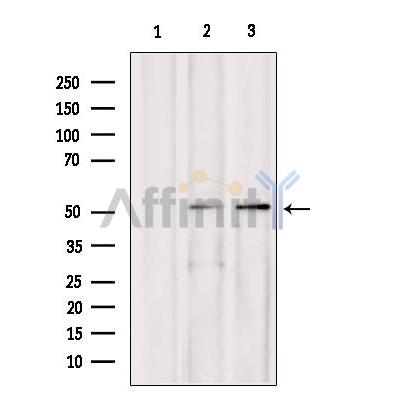AEBP2 Antibody - #DF12245
| Product: | AEBP2 Antibody |
| Catalog: | DF12245 |
| Description: | Rabbit polyclonal antibody to AEBP2 |
| Application: | WB IHC |
| Reactivity: | Human, Mouse, Rat |
| Prediction: | Pig, Zebrafish, Bovine, Horse, Sheep, Rabbit, Dog, Chicken |
| Mol.Wt.: | 52 kDa; 54kD(Calculated). |
| Uniprot: | Q6ZN18 |
| RRID: | AB_2845050 |
Related Downloads
Protocols
Product Info
*The optimal dilutions should be determined by the end user. For optimal experimental results, antibody reuse is not recommended.
*Tips:
WB: For western blot detection of denatured protein samples. IHC: For immunohistochemical detection of paraffin sections (IHC-p) or frozen sections (IHC-f) of tissue samples. IF/ICC: For immunofluorescence detection of cell samples. ELISA(peptide): For ELISA detection of antigenic peptide.
Cite Format: Affinity Biosciences Cat# DF12245, RRID:AB_2845050.
Fold/Unfold
Adipocyte enhancer binding protein 2; Adipocyte enhancer-binding protein 2; AE (adipocyte enhancer) binding protein 2; AE binding protein 2; AE-binding protein 2; AEBP 2; AEBP2; AEBP2_HUMAN; MGC17922; Zinc finger protein AEBP2;
Immunogens
A synthesized peptide derived from human AEBP2, corresponding to a region within the internal amino acids.
- Q6ZN18 AEBP2_HUMAN:
- Protein BLAST With
- NCBI/
- ExPASy/
- Uniprot
MAAAITDMADLEELSRLSPLPPGSPGSAARGRAEPPEEEEEEEEEEEEAEAEAVAALLLNGGSGGGGGGGGGGVGGGEAETMSEPSPESASQAGEDEDEEEDDEEEEDESSSSGGGEEESSAESLVGSSGGSSSDETRSLSPGAASSSSGDGDGKEGLEEPKGPRGSQGGGGGGSSSSSVVSSGGDEGYGTGGGGSSATSGGRRGSLEMSSDGEPLSRMDSEDSISSTIMDVDSTISSGRSTPAMMNGQGSTTSSSKNIAYNCCWDQCQACFNSSPDLADHIRSIHVDGQRGGVFVCLWKGCKVYNTPSTSQSWLQRHMLTHSGDKPFKCVVGGCNASFASQGGLARHVPTHFSQQNSSKVSSQPKAKEESPSKAGMNKRRKLKNKRRRSLPRPHDFFDAQTLDAIRHRAICFNLSAHIESLGKGHSVVFHSTVIAKRKEDSGKIKLLLHWMPEDILPDVWVNESERHQLKTKVVHLSKLPKDTALLLDPNIYRTMPQKRLKRTLIRKVFNLYLSKQ
Predictions
Score>80(red) has high confidence and is suggested to be used for WB detection. *The prediction model is mainly based on the alignment of immunogen sequences, the results are for reference only, not as the basis of quality assurance.
High(score>80) Medium(80>score>50) Low(score<50) No confidence
Research Backgrounds
DNA-binding transcriptional repressor. May interact with and stimulate the activity of the PRC2 complex, which methylates 'Lys-9' and 'Lys-27' residues of histone H3.
Nucleus.
Belongs to the AEBP2/jing C2H2-type zinc-finger family.
Restrictive clause
Affinity Biosciences tests all products strictly. Citations are provided as a resource for additional applications that have not been validated by Affinity Biosciences. Please choose the appropriate format for each application and consult Materials and Methods sections for additional details about the use of any product in these publications.
For Research Use Only.
Not for use in diagnostic or therapeutic procedures. Not for resale. Not for distribution without written consent. Affinity Biosciences will not be held responsible for patent infringement or other violations that may occur with the use of our products. Affinity Biosciences, Affinity Biosciences Logo and all other trademarks are the property of Affinity Biosciences LTD.



























